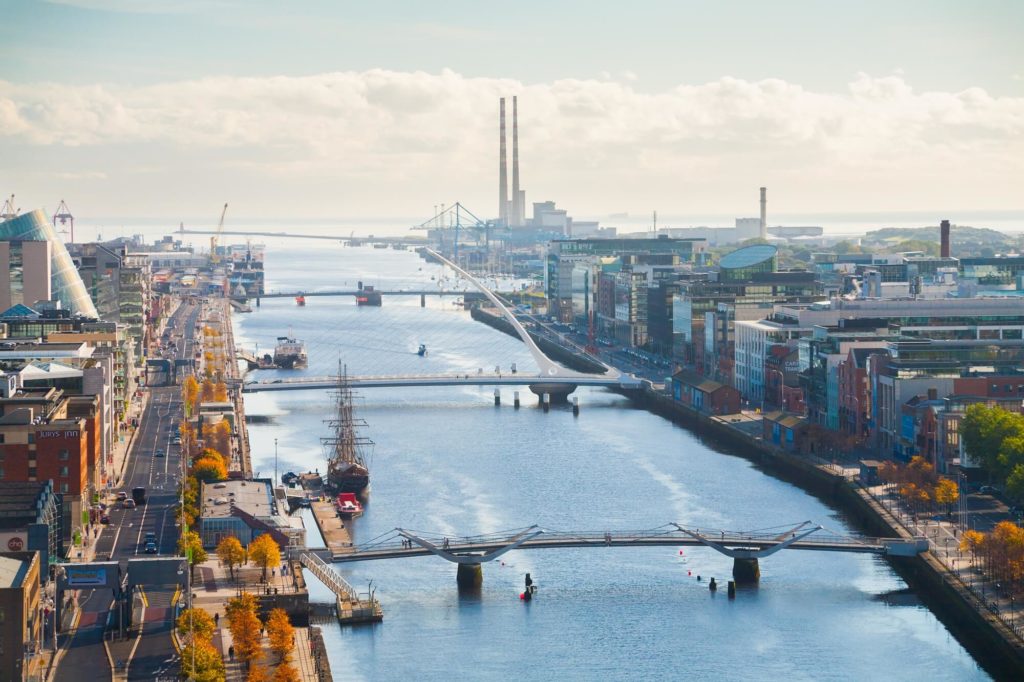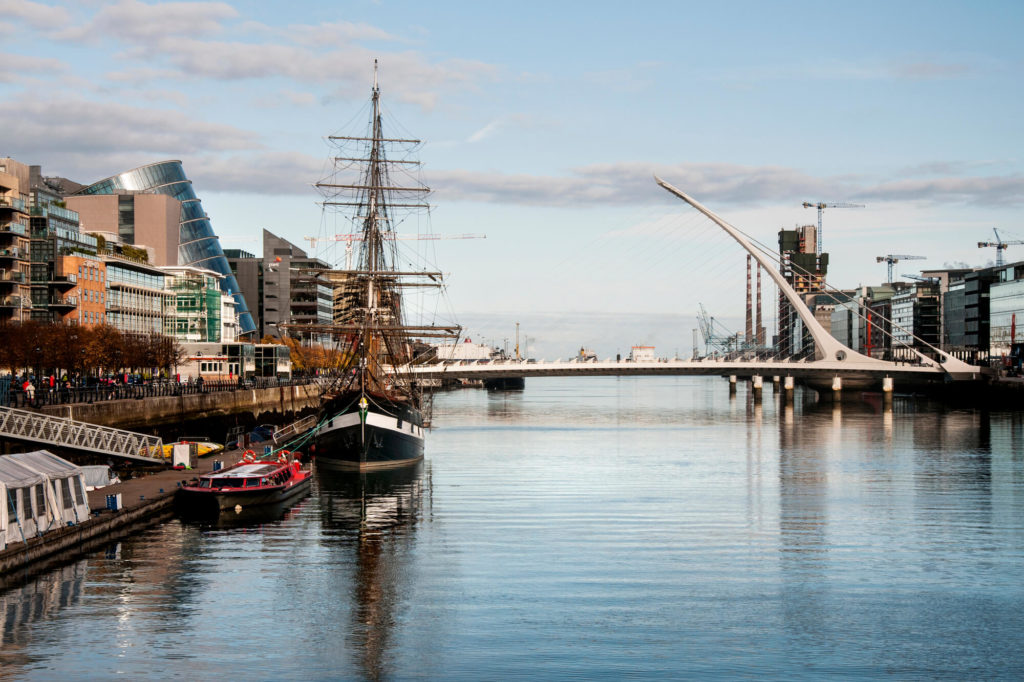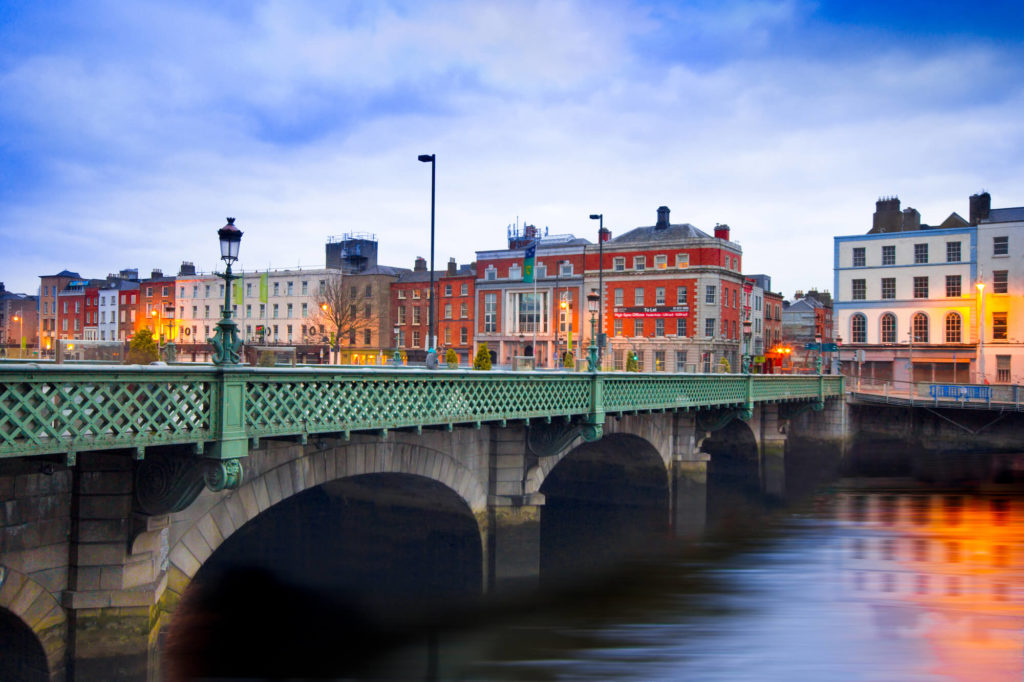26 Oct Meet Dublin In A Couple of Hours – A Walk Along the Liffey River
Whether you’re a local or a tourist, Dublin will always have something fresh to offer. New bars and shopping centres will open over the years. People will move in and out of the city in pursuit of happiness.
But one thing will remain unchanged for a long time to come — the river Liffey dividing the capital of Ireland in two.

The Liffey is the border between the Northside and the Southside. Admittedly, not a lot of Dublin’s main attractions are right next to the river bank. But it is the most logical route across the city.
And, as you’ll soon see, a walk along the Liffey will be far from bland.
The Docklands

The Docklands is an area in the east of Dublin, on both sides of the Liffey. It used to be a rundown area, but it’s been undergoing extensive renovations in the recent years.
Find the offices of the Dublin Docklands Development Authority. They’re between the International Financial Services Centre and Jurys Hotel. Nearby you’ll find a pedestrian bridge — the Sean O’Casey Bridge.
When you step onto the Sean O’Casey Bridge, to the east you can see a bridge shaped like a harp. That’s the Samuel Beckett Bridge. Also, you ‘ll see the harbour where the tall ship “Jeanie Johnston” can be found berthed.
If you go south across the pedestrian bridge, you’ll find a memorial to merchant marines who lost their lives during the “Emergency” in WWII. Nearby, you’ll also find a bronze statue of a worker – “The Linesman”.
Continue westwards and, you’ll come across a contemporary road bridge – the Matt Talbot Memorial Bridge. Matt Talbot is a venerated Dublin mystic, and a statue of him can be found at the southern end of the bridge.
While you’re there, take some time to enjoy some beautiful Dublin sights. To your left is the Custom House and straight across the Liffey is the modern IFSC. You can then cross the bridge and find a group of people made of bronze. If you feel discomfort while looking at them, that’s a compliment to the artist. That’s the Famine Memorial.
From there, continue westwards and pass the Custom House, and have your smartphone ready. You can take some amazing photos of the structures nearby for your Instagram feed.
Continue upstream along the Liffey, under the appalling railway bridge and pass the Butt Bridge. To your right, you’ll see a tall hulk. That’s Liberty Hall — Dublin’s tallest building and the headquarters of the trade union. Opposite Liberty Hall, under the elevated railway, is a statue of James Connolly. He was an Irish-American socialist.
Meanwhile, remnants of Dublin’s maritime past can be seen on the buildings on along the river bank.
The Centre of Dublin
Further upstream is a curious-looking bridge – the O’Connell Bridge, which is wider than it is longer. As you approach it, you’ll enter the heart of Dublin. To your right will be O’Connell Street. From there continue along Bachelor’s Walk. You’ll soon be at the Ha’penny Bridge.
The official name of the bridge is the Liffey Bridge. Before that, it was the Wellington Bridge. However, there was a toll of half a penny for pedestrians in the past, and the nickname Ha’penny Bridge stuck.
You can cross the bridge free of charge today. On the other side, you’ll find a small lane, opposite the Ha’penny Bridge. Follow it, and you’ll enter the Temple Bar District. For now, let’s turn right and continue walking to the Millennium Bridge. There we can cross the river again.
Viking Dublin

Just before the Grattan Bridge, across Liffey, is a grated tunnel entrance. The tunnel serves as an outlet for of the River Poddle, which formed a “dark pool” nearby.
It was here that the Vikings established a settlement long ago. When you cross the Grattan Bridge, you can see the entrance to Dublin Castle at the end of Parliament Street. You can also see the Sunlight Chambers next to the bridge.
Further along the Liffey, you’ll find a peculiar set of park benches to your left. They’re arranged so as to recreate the image of a sinking Viking longboat. In fact, the prow of the boat was what served as the inspiration for the monument outside the council offices. And as you walk on, you’ll notice there are bronze inlets in the pavement. They represent the Viking artefacts dug up in the area a few years ago.
Soon you’ll find yourself in the heart of Viking Dublin. Make sure you take in the views as you approach the O’Donovan Rossa Bridge. To the south, you can see Christ Church Cathedral. And to the north, you can see the Four Courts lining the Liffey.
Continue walking along the southern bank.
The Guinness Brewery
Eventually, you’ll reach the Father Mathew Bridge. Theobald Mathew was an Irish Catholic priest, founder of the temperance movement.
Don’t be surprised if you smell malt while you’re here. The tall structure you can see is the old chimney of the Jameson Distillery. Also, the Guinness Brewery is nearby as well. You’ll pass it as you continue upstream along the Liffey.
And as you keep walking, you’ll pass the Mellowes Bridge, Blackhall Bridge, and Rory O’More Bridge. Finally, you’ll reach the Frank Sherwin and the Sean Heuston Bridge.
The Final Steps
As you’re going east, you’ll reach the Heuston Station. Then you can cross to the quays on the northside. If you go back downstream, on your left you’ll find the Civil Defence Depot. Next to it is a park. That’s the Croppy Acre, a mass grave where lay the people killed in the Irish Rebellion of 1798. Once you’ve passed it, go left and you’ll soon be at the Collins Barracks – The National Museum of Ireland.
At this point, you’ll probably be looking for a café to replenish your energy. Luckily, you can easily find one in this area. And after you’ve rested, you can take a LUAS tram back to the city centre. Or, if you feel like it, you can continue walking west. Nearby are the Dublin Zoo, the Phoenix Park and the War Memorial in Island Gardens.



Sorry, the comment form is closed at this time.